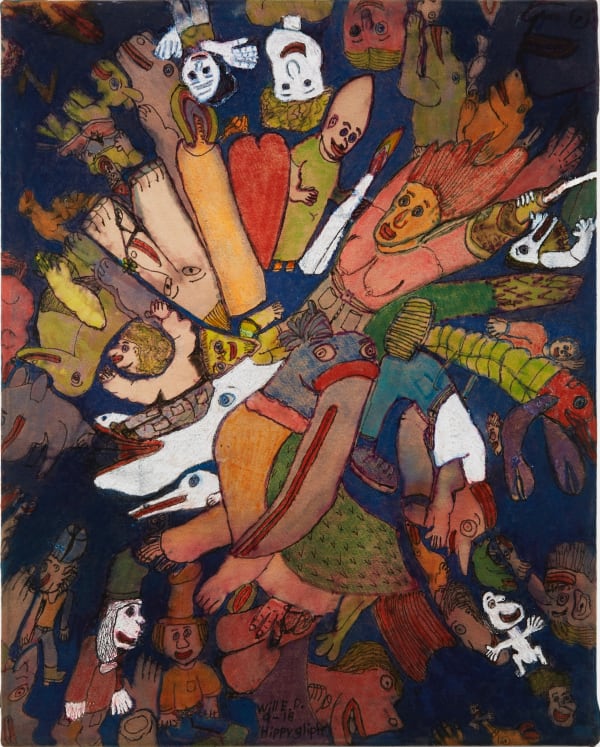William Eugene Doleman was born in San Francisco in 1949. His paternal grandparents were dairy farmers, but his father, having a talent and curiosity for electronics, attended Stanford to become an engineer and metallurgist—and worked making tank armor during World War II.
Since 1991, Doleman has been living on and off in Grass Valley, California, a small mining town in the foothills of the Sierra Nevada Mountain range. A self-described “volunteer peasant” and an eccentric, he has lived in and out of a trailer for 50 years. “My parents went through the Depression when they were young teens,” he says. “That had an effect on me… They were very frugal, they lived off very little,” adding that he is planning on fixing up a motor home that he recently purchased—which will put him on his way to becoming a true nomad.
In the 1970s, Doleman lived in a commune in Lewis County, Tennessee (named The Farm) and also spent some time in Louisiana—before becoming a plumber in his late twenties. It was only when he retired at the age of 65, due to sinus health problems caused by the PVC glue used in his trade, when he started pursuing art in earnest. Doleman is also seriously invested in herbology, alternative medicine, and a concept of spirituality where humans and their environment are intrinsically connected: “I look at it as a beam of light coming out of the top of my head and straight out into the universe. The earth is turning, so this rod of light that is me in the heavens is part of the universe. If you think of that as a steering stick, I can use it to actually make some changes in the universe and change myself in the process.”
When he moved to California, Doleman started to tie-dye fabrics, and at one point it occurred to him to cut and stretch them to utilize as canvases. This pre-existing color base serves as inspiration for the drawings that emerge: whirlpools of figures with varying degrees of human and animal traits that coexist happily in a flexible non-perspectival space—which Doleman manipulates by removing some of the color (or un-dying) to create negative spaces, luminosity, and contrast.
The artist describes his process as meditative; a kind of “no-mind’ state where he is able to communicate with good spirits and create his own version of the Garden of Eden; a place of absolute harmony; beaming with intoxicating colors and uncontainable joie de vivre. “In my works, figures are in crowded conditions, but nobody is scowling at each other, they’re all smiling because they’re happy to be there, it’s an acceptance that I think all people need to have, with each other and the environment,” he says. The word “Hippygliph” is often floating within these compositions, as Doleman thinks of his works as hieroglyphs of his generation.
-
All works: Mixed media on cotton fabric, stretched on canvas
-
-
 Untitled, 2014Mixed media on cotton fabric, stretched on canvas16 x 20 in.(WED 6)SOLD
Untitled, 2014Mixed media on cotton fabric, stretched on canvas16 x 20 in.(WED 6)SOLD -
 Untitled, n.dMixed media on cotton fabric, stretched on canvas20 x 16 in.(WED 4)$6,500
Untitled, n.dMixed media on cotton fabric, stretched on canvas20 x 16 in.(WED 4)$6,500 -
 Untitled, 2018Mixed media on cotton fabric, stretched on canvas20 x 16 in.(WED 9)SOLD
Untitled, 2018Mixed media on cotton fabric, stretched on canvas20 x 16 in.(WED 9)SOLD -
 Untitled, n.dMixed media on cotton fabric, stretched on canvas16 x 20 in.(WED 1)$6,500
Untitled, n.dMixed media on cotton fabric, stretched on canvas16 x 20 in.(WED 1)$6,500
-
-
-
 Untitled, n.dMixed media on cotton fabric, stretched on canvas16 x 12(WED 11)$5,500
Untitled, n.dMixed media on cotton fabric, stretched on canvas16 x 12(WED 11)$5,500 -
 Untitled, n.dMixed media on cotton fabric, stretched on canvas12 x 16 in.(WED 3)$5,500
Untitled, n.dMixed media on cotton fabric, stretched on canvas12 x 16 in.(WED 3)$5,500 -
 Untitled, 2018Mixed media on cotton fabric, stretched on canvas12 x 16 in.(WED 10)$5,500SOLD
Untitled, 2018Mixed media on cotton fabric, stretched on canvas12 x 16 in.(WED 10)$5,500SOLD -
 Untitled, n.dMixed media on cotton fabric, stretched on canvas12 x 16 in.(WED 8)$5,500
Untitled, n.dMixed media on cotton fabric, stretched on canvas12 x 16 in.(WED 8)$5,500
-










